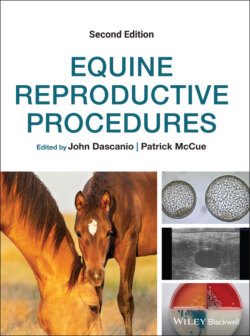Читать книгу Equine Reproductive Procedures - Группа авторов - Страница 16
Оглавление5 Perineal Conformation Evaluation
John J. Dascanio
School of Veterinary Medicine, Texas Tech University, USA
Introduction
Perineal conformation evaluation is an integral part of the mare breeding soundness examination and should be performed in any mare presented for reproductive evaluation. While there could be defects present in the perineal area, such as from trauma, most commonly evaluation is directed to the vulva. The vulva serves as the first barrier to contamination of the reproductive tract. Defects in perineal conformation may predispose the reproductive tract to inflammation and infection.
Defects in perineal conformation are most often remedied by performing vulvoplasty (Caslick operation, Chapter 53). Alternative surgical perineal procedures include the Pouret operation, Slusher vestibuloplasty, or Gadd technique.
Equipment and Supplies
Tail wrap, exam gloves, flashlight.
Technique
Wearing examination gloves, hold the tail to the side so as to visualize the anus, perineum, and vulva.
Visualize the declination of the vulvar lips from vertical (Figure 5.1).
Note any disruption to the labia such as from previous trauma or surgeries.
Note any discharges from the vulva or on the skin ventral to the vulva. Purulent discharges may accumulate as a crusty discharge on the skin of the vulva and ventral perineum (Figure 5.2). Since the tail is usually relaxed and lying against the vulva, discharges often accumulate on the ventral aspect of the tail in the tail hairs. This area should be examined prior to placement of a tail wrap as a clue that there is a passive vaginal discharge.Figure 5.1 Normal conformation with two thirds of the vulvar opening lying below the level of the pelvic brim.Source: From Descanio JJ. 2011. External reproductive anatomy. In: McKinnon AO, Squires EL, Vaala WE, Varner DD (eds). Equine Reproduction, 2nd edn. Ames, IA: Wiley Blackwell, pp. 1577–81. Reproduced with the permission of John Wiley & Sons.
Normal urine crystal/mucus accumulation on the ventral labia may appear as a chalky white discharge, especially evident when mares are in heat (Figure 5.3). There should be no discharge on the ventral skin or in the tail hairs since this is a normal finding.
Wearing exam gloves, push the index fingers on either side of the labia to determine the relationship of the vulvar opening to the ventral pelvis.
Place the thumbs on either side of the labia and pull the labia apart, exposing the vestibule to perform the Windsucker test (Figure 5.4) and thus test the integrity of the vestibulo‐vaginal fold. The vestibulo‐vaginal fold is a barrier to contamination of the anterior reproductive tract and should be intact in a normal mare. When the labia are separated, the vestibulo‐vaginal fold will prevent air from entering the vagina. An in‐rush of air or a “slurping” of air into the vagina occurs in mares with a non‐functional vestibulo‐vaginal fold.
Figure 5.2 Mare with a purulent vaginal discharge and dried discharge on the inner aspect of the hind legs.
Interpretation
The vulva should be vertically orientated.
The labia should meet without disruption of the mucosal seal.
Two thirds or more of the vulvar opening should be below the pelvic brim.
Upon separation of the vulvar lips and visualization of the vestibulo‐vaginal fold, no air should enter the vagina.
Figure 5.3 Normal chalky white discharge on the ventral labia from urination.
Figure 5.4 Mare with a positive Windsucker test. The arrow points at the opening into the cranial vagina. The vestibulo‐vaginal fold is non‐functional in this mare.
Reference
1 Dascanio JJ. 2011. External reproductive anatomy. In: McKinnon AO, Squires EL, Vaala WE, Varner DD (eds). Equine Reproduction, 2nd edn. Ames, IA: Wiley Blackwell, pp. 1577–81.
Further Reading
1 Gadd JD. 1975. The relationship of bacterial cultures, microscopic smear examination and medical treatment to surgical correction of barren mares. Proc Annu Conv Am Assoc Eq Pract 21: 362–8.
2 Pascoe RR. 1979. Observations on the length and angle of declination of the vulva and its relation to fertility in the mare. J Reprod Fertil Suppl 27: 299–305.
3 Pouret EJM. 1982. Surgical technique for the correction of pneumo‐ and urovagina. Eq Vet J 14: 249.
